Pushbutton Switches are everywhere, like refrigerator doors, gaming consoles, home appliances, industrial panels, etc.
And if you are a knowledge seeker, a company owner, or a wholesaler looking to learn what they are exactly, how they work, their types of switches, and why they are used in place of standard switches, then you have come to the correct spot.
1) What is a Push Button Switch?
“As the name suggests, Pushbutton switches are electrical switches that work by pressing ( pushing ) the button.”
Push switches can be found in various applications like PCs, phones, industrial machines, and appliances. In addition, they are used in gaming consoles like the Xbox and PlayStation.
Push switches can be made of plastic or metal, or both materials. Moreover, they come in various styles, sizes, and colors for multiple needs.
They can have a round, rectangular, or oval shape. The buttons can be flush-mounted or raised. It is common for colors to be black and white, but they can also be green, red, or blue for function differentiation on a single panel which helps quick identification in emergencies.

Based on their function, Push Button Switches can be divided into 2-types;
i) Momentary Push Button Switches
ii) Latching Push Button Switches
ⅰ) Momentary Push Button Switches
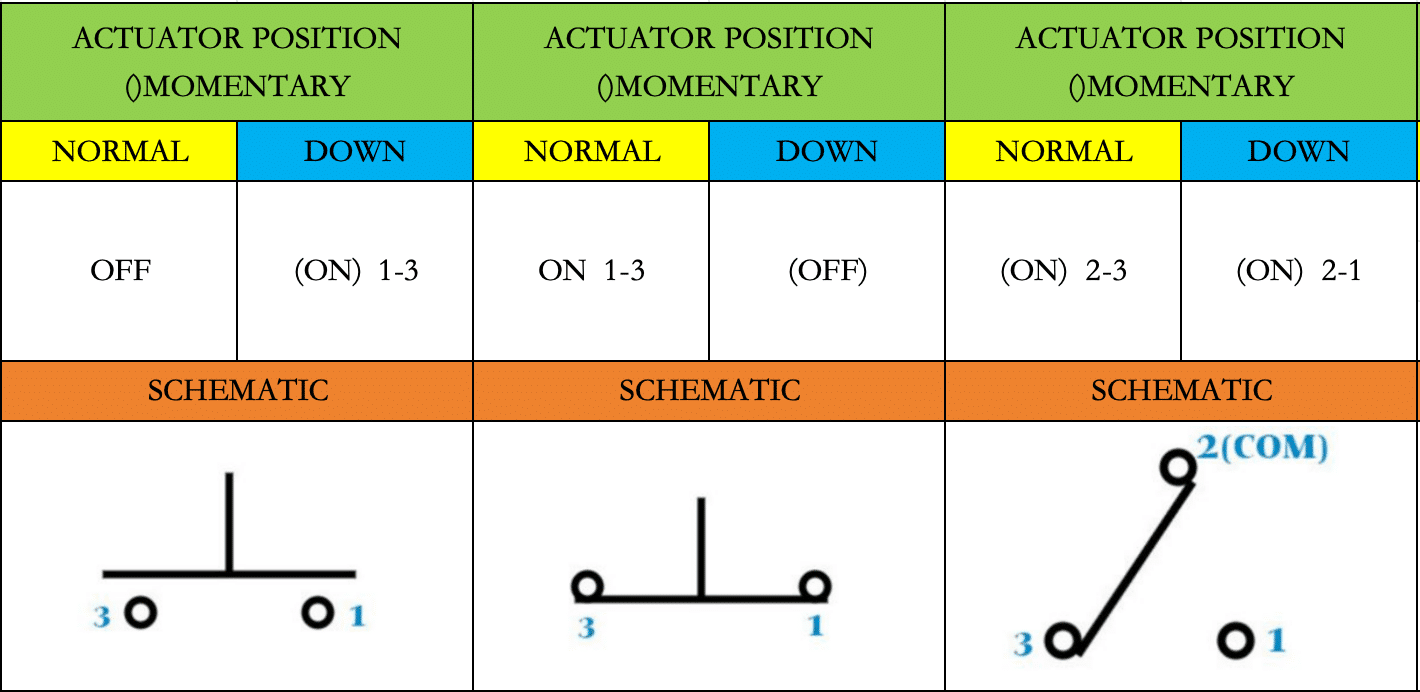
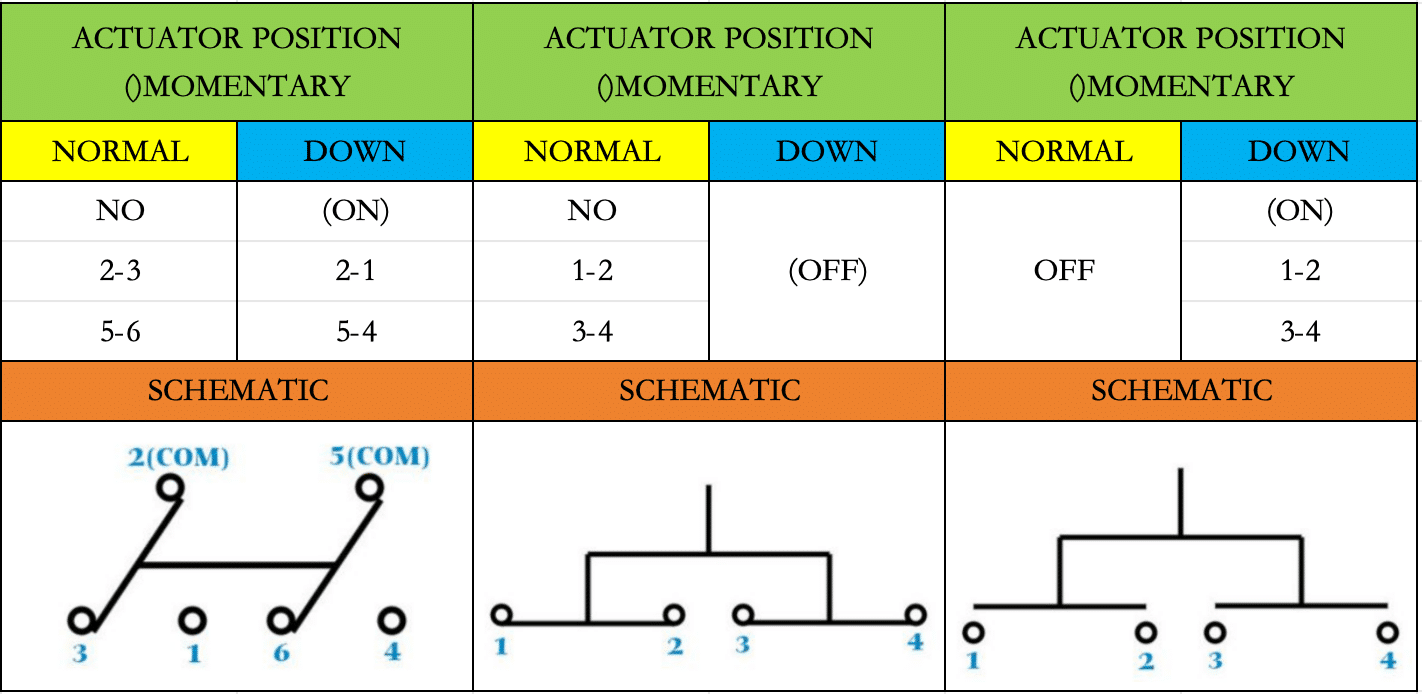
“For a Momentary Push Button Switch to function, it has to be pushed constantly, and when you release it, it will return to its normal position.”
As the name suggests, the Momentary Push Switch functions only briefly ( when the button is pressed ), making it appropriate for applications such as momentary lighting control like refrigerator door lights, etc. These are also called non-latching push button switches.
Basically, there are 2-kinds of Momentary Push Button Switches;
● Push to Make
● Push to Break
Push to Make | Push to Break | |
| Diagram | 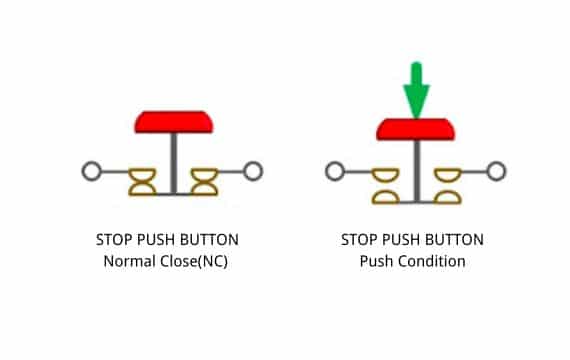 | 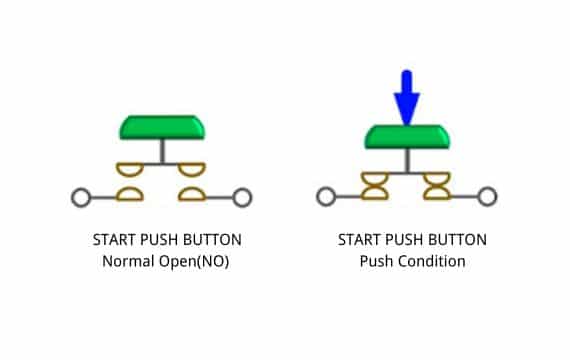 |
| Working | “Their electrical circuit is open when not pushed, meaning their current is off. But when you push them, the electrical circuit is connected, and the current starts moving.” | “When not pushed, their electrical circuit is closed & current is flowing. But when you push them, the electrical circuit breaks, turning off the current.” |
| Naming Reason | “As they are making a electrical circuit when pressed, that’s why they are called Push to Make switches.” | “As they break the current flow when pushed, they are named Push to Break.” |
| Also known as | “As these switches are always off in their normal not pushed state due to their open circuits, they are known as Normally Open ( NO ) Switches.” | “As these switches are always on in their non-pushed state due to their closed circuit, they are also known as Normally Closed ( NC ) Switches.” |
➔ Some Famous Examples
Below are some famous examples of Momentary Push Button switches, but they only count as the tip of the ice burg in these switches’ various applications;
● Controlling electric locks or entry systems in security applications.
● Operating garage door openers, allowing temporary and controlled access.
● Triggering a camera shutter for capturing photos in photography or videography.
● Activating voice recording or playback functions in audio devices or communication systems.
● Initiating a call or answering a call in telecommunication devices or hands-free systems.
● The Refrigerator door switch turns on the bulb when the gate is opened and turns it off when you close the door.
● Much more.
ii) Latching Push Button Switch
“As the name suggests, Latching Push Button Switch, when pressed, maintains its electrical circuit state ( biome latched ), and it will only change its state when the user pushes it again.”
Unlike Momentary switches, they don’t need a constant push to work. For example, a 2-state on/off Latching push switch works in the following way;
➢ When you push it once, it will turn on from its off state, and the circuit will remain on, even when the user removes his hand.
➢ When you push it again, it will change its state from on to off and maintain its condition until it is pressed again.
➔ Some Famous Examples
● Car Engine Start power switch to turn off and on a vehicle.
● Home automation systems for controlling various functions like opening/closing curtains, turning on/off appliances, or adjusting room temperature.
● Control machinery and equipment in industrial settings.
● Audio equipment for toggling between different audio sources or modes.
● Lighting control panels where the user can toggle between different lighting configurations.
● Motor controls in industrial machinery allow operators to set and maintain the desired speed or direction.
● Power switches in electronic devices where the user wants to get specific on/off state until intentionally changed.
● More.
| Note “It is important to note that no matter its a momentary or latching push button switch, the button itself will always return to its normal state, irrespective of its electrical circuit state.” |
3) How do Push Button Switches work?
Before understanding how it works, it is best to recognize the components, which are;
● A button, also known as an Actuator.
● A long rod on which the button is fixed.
● A spring in the rod; forces the button to get to its normal state when you stop pushing.
● A metal bar, which is set on another end of the rod.
● There are two separate terminals; one has current, and one doesn’t.
● A plastic/metal casing that encloses all components.
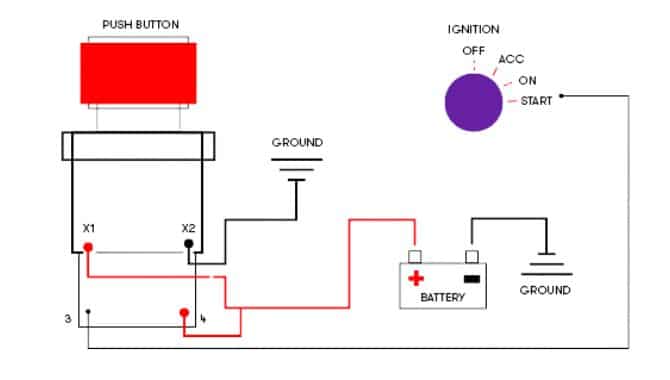
So, when you press a button, a downward force moves the button, the rod attached to it, and finally, the metal bar attached to the rod bottom all move downward. Then next, the work is different;
i) In Momentary Switches
ii) In Latching Switches
i) In Momentary Switches:
➢ In Normally Open ( NO ) switches, the terminals are present at the base. So, when the metal bar reaches them, it acts as a bridge between these two separated points and completes the circuit; the current start flowing. And when you release the button, the spring pushes back the rod & the metal bar upward, which breaks the circuit, and the current stop flowing.
➢ In Normmaly Closed ( NC ) Switches: the circuit terminals are at the start of the casing, so when you press the button, the metal moves downward, far from the terminals, which breaks the circuit ( turn it off ). And when you release the button, the spring moves and the metal bar moves upward and completes the circuit again ( current starts flowing ). Only Momentary circuits are common in this setup; latching switches with an NC mechanism are rare.
ii) In Latching switches:
These have mostly NO mechanism, in which a latch holds a metal bar in its place while the spring pushes the button to its usual place. And when you press the button again, the latch releases the metal bar, which moves upward, breaking the circuit.
There are many kinds of switches worldwide, and everyone has pros and cons. And if you are looking to find out the difference between Push Button Switches & Rocker Switches so you can find the best ones according to your needs, in that case, see the chart below;
| Push Button Switch | Rocker & Toggle Switches | |
| Activation method | ● Pressing a button or actuator | ● Flipping a lever or toggling a switch |
| Beauty | ✓✓✓ | ✓ |
| Ease to Operate | ✓✓✓ | ✓✓ |
| Quick Operation | ✓✓✓ | ✓✓ |
| Designed for high voltage & current | ✓✓✓ | ✓ |
| Durability | ✓✓✓ | ✓ |
| Cost | ||
| Tactile Feedback | ✓✓✓ | X |
| Ease of Installation | ✓✓✓ | ✓✓ |
| No Accidental Pushing | ✓✓✓ | X |
| Require less space to install | ✓✓✓ | X |
| It can include multiple operations in a single switch | ✓✓✓ | X |
| Usage | ● Mostly for consumer appliances & industrial machines | ● For lights & appliances in a home, offices, and other similar places. |
1. Can Push Button Switches Be Used In Outdoor Or Harsh Environments?
Yes, push switches are normally easy to install and easily incorporated into electrical panels & boards.
2. Are Push Button Switches Easy To Install?
Yes, pushbutton switches are generally easy to install and can be easily integrated into electrical panels & boards.
3. What Additional Features Are Present in Push Button Switches?
Push button switches come with multiple modifications to make the process easy & safe for the user, such as;
● A led-light indicator is fixed on the button to tell it on/off and other states
● A built-in lock is put on the button so no authorized user can use it.
● A threaded metal case, which makes them impossible to get them out from the panel by vandals. These Anti-Vandal switches are designed for public machines & appliances.
➔ Conclusion
There are thousands of models of Push Button Switches in the market. And if you are looking to find the best switch for yourself, there are many factors to consider, like voltage & current rating, size, led-light, manufacturing material, environmental durability or not, momentary or latching mechanism, etc.
And if you are unsure about that and want to get the best push buttons at budget-friendly prices, then you can contact us at WEUP. Since 1987, we have manufactured millions of relays, switches, and connectors for our customers. We have products for every industry, like automotive, manufacturing machines, homes, offices, commercial places, public machines, and much more.
Just contact us and get our advice & sample products for free.
Author
Hello, my name is Eva Xia, and I am currently the Marketing Manager at Yueqing Weup Technology Co., Ltd, located in Wenzhou, Zhejiang, China. With over a decade of experience in the accounting field, I have developed extensive knowledge and skills that enable me to excel in my role. Additionally, I have spent two years working as an English teacher, which enhanced my communication abilities and instilled discipline within me.
Having gained more than three years of valuable experience in overseas sales, I have had the opportunity to expand my horizons and develop a deeper understanding of the commercial landscape. This exposure has nurtured my business understanding and allowed me to navigate diverse markets confidently.
However, despite my accomplishments thus far, I remain dedicated to continuous growth and learning. My current area of focus revolves around electronic switches. It is a fascinating and dynamic field that constantly evolves with technological advancements. By delving deeper into this realm, I aim to enhance my professional knowledge and stay ahead of industry trends.
In summary, as a Marketing Manager at Yueqing Weup Technology Co., Ltd., I bring forth a wealth of experience in accounting coupled with the valuable skills honed during my time as an English teacher. Furthermore, my extensive overseas sales expertise has sharpened my business acumen. With a relentless thirst for knowledge and a specific interest in electronic switches, I strive to enhance my professional capabilities further while contributing positively to our organization’s success.
Get in Touch for More Insights!
If you’ve found the information helpful and want to learn more, I encourage you to reach out. Whether your questions concern our latest industry trends, electronic switches, or other market insights, I’m here to help!
Don’t hesitate to drop me an email at the below table.
I am looking forward to hearing from you soon!
Eva Xia,
Marketing Manager at Yueqing Weup Technology Co., Ltd


